|
|
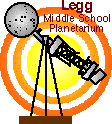 |
![]()
Planetarium Home Page
- Constellation Page -
Directions
Page - Observation
Sheet
Ursa Major Guide -
Orion
Guide - Pegasus Guide
- Moon Phases
![]()
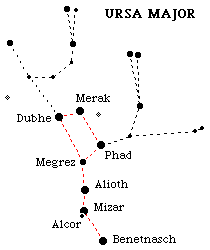 How
to find Ursa Major How
to find Ursa MajorUrsa Major is probably the first constellation you learned when you were a small child. It is better know as the "Big Dipper." The first thing you need to do in order to find Ursa Major is to locate the direction north. Once you have found the direction north, look for an area of sky with some bright stars. The seven stars that make up the "Big Dipper" are some of the brighter stars in this section of the sky. When you think you've found this part of Ursa Major, check with you planetarium notes to make sure you are correct. After you have found the "Big Dipper", try to make out the rest of the Great Bear. Now that you have found Ursa Major, you are ready to use it as a guide to the rest of the northern constellations. |
![]()
Ursa Major is probably better know as the "Big Dipper." The dipper is easy to spot in the night sky, because it will look like a giant ladle. The constellation of Ursa Major is larger than just the dipper. The dipper forms the back half of the Great Bear with the handle outlining its tail. Ursa Major contains a total of fifty-three (53) visible stars. Begin with the stars Dubhe and Merak. These two stars are known as the "pointer stars" and they will help you locate the North Star, Polaris. These are the two stars at the end of the cup of the "Big Dipper." Another interesting pair of stars is in the middle of the handle of the dipper. Their names are Mizar and Alcor. Alcor is so close to Mizar that they appear to be one star. In ancient times, armies used these two stars as an eye test. If you can see two separate stars your eyesight is good, if not, your eyes could not be relied upon during battle.
![]()
 Finding
Polaris and Ursa Minor Finding
Polaris and Ursa MinorTo find the star Polaris and the constellation Ursa Minor, locate the two end stars in the cup of the "Big Dipper." Connect a line through these two stars. This will point to the star Polaris. Polaris is in the constellation Ursa Minor. Ursa Minor is better known as the "Little Dipper." Polaris will not be an extremely bright star, about the same brightness as the "pointer stars." Polaris is also known as the North Star because it is directly above the Earth's North Pole. This star is about fifty (50) light years away from Earth. |
![]()
 Finding
Cassiopeia Finding
CassiopeiaTo find the constellation Cassiopeia, locate the second star in the handle of the "Big Dipper" and Polaris. Connect a line through this star from Ursa Major through Polaris. This will point you through Polaris and on to a "W" or "M" shaped constellation. This is "the queen," Cassiopeia. The stars of Cassiopeia are not excessively bright. This will make Cassiopeia a difficult constellation to locate. |
![]()
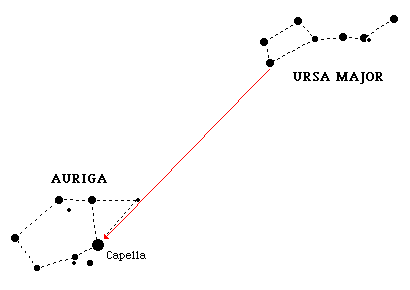 Finding
Capella and Auriga Finding
Capella and AurigaTo find the star Capella and the constellation Auriga, locate the top two stars in the cup of the "Big Dipper." Connect a line through these two stars leading away from Ursa Major. This line will point to the bright star Capella in the constellation Auriga. Capella is the sixth brightest star in the night sky and is about forty (40) light years away. Capella is actually a double star; both stars are larger than our own Sun. |
![]()
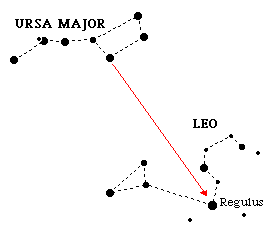 Finding
Regulus and Leo Finding
Regulus and LeoTo find the star Regulus and the constellation Leo, locate the two inner most stars of the cup of the "Big Dipper." Connect a line through these stars extending from the bottom of the "Big Dipper." This line will point to the bright star Regulus in the constellation Leo. Regulus is the twenty-first brightest star we see at night. It is eighty-three (83) light years away from Earth and is seventy-five (75) times brighter than the Sun. |
![]()
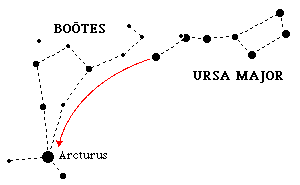 Finding
Arcturus and Bo÷tes Finding
Arcturus and Bo÷tesTo find the star Arcturus and the constellation Bo÷tes, locate the handle of the "Big Dipper." Continue the curve of the handle to the bright star Arcturus. Arcturus is the third brightest star in the night sky and may look to be a light orange color. You have just found one of the bottom stars in the constellation Bo÷tes. Arcturus is thirty-three (33) light years away and is thirty (30) times the diameter of our Sun. |
![]()
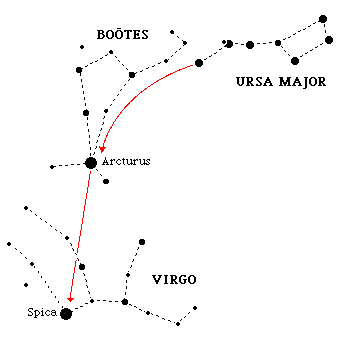 Finding
Spica and Virgo Finding
Spica and Virgo To find the star Spica and the constellation Virgo, start by following the method you used to find Arcturus in Bo÷tes. Continue the curve of the handle of the "Big Dipper" to the bright star Arcturus. From Arcturus, continue the curve until you reach another bright star, Spica. Spica is a blue star, two hundred fifteen (215) light years away from Earth. |
![]()
 Finding
Pollux and Gemini Finding
Pollux and GeminiTo find the star Pollux and the constellation Gemini, locate the stars in the cup of the "Big Dipper." One star that will help you find Pollux is the star that joins the cup and the handle together. Connect a line from this star through the center of the cup to the bottom end star. Continue on this line until you run into the bright star Pollux. Pollux is the seventeenth (17) brightest star in the night sky and the fifteenth (15)closest star to our solar system at forty (40) light year's away. Pollux forms one of the two heads of the "twins," Gemini. Castor forms the other head of the "twins." |
![]()
 Finding
Alrai and Cepheus Finding
Alrai and CepheusTo find the star Alrai and the constellation Cepheus, locate the two end stars in the cup of the "Big Dipper." Connect a line through these two stars. This will point to the star Polaris. Continue through Polaris and onto Alrai. Alrai marks the point of the constellation Cepheus. This star is not all that bright, but Cepheus is not known for its bright stars. Cepheus was an important constellation in Greek mythology. He was the King of Ăthiopia (not present day Ethiopia). This constellation is entangled in mythology with Andromeda (his daughter), Cassiopeia (his queen), Cetus (the monster), Pegasus (helped Perseus), and Perseus (saved Andromeda). |
![]()
 Finding
Albireo and Cygnus Finding
Albireo and CygnusTo find the star Albireo and the constellation Cygnus, locate the two inner most stars of the cup of the "Big Dipper." Connect a line through these stars extending from the top of the "Big Dipper." This line will lead you just past the "Guardians of the Pole" in Ursa Minor (the "Little Dipper"). Continue on the line and you will find to the star Albireo in the constellation Cygnus. Albireo forms the head of the Swan, Cygnus. The constellation Cygnus is some times called the "Northern Cross." Albireo forms the bottom of the cross and Deneb forms the top part of the cross. This line between Albireo and Deneb also forms the body of the swan. Deneb is the brightest star in Cygnus and is the nineteenth (19) brightest star in the night sky. |
![]()
Planetarium Home Page
- Constellation Page -
Directions
Page - Observation
Sheet
Ursa Major Guide -
Orion
Guide - Pegasus Guide
- Moon Phases